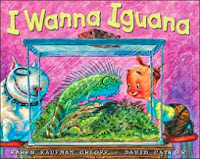Here are some picture book animals that defy common wisdom.
What do you think of when you think “exotic animal?” Alpacas? Komodo dragons? Marmosets? Pythons? Blue-tongued skinks and Argentinean tegus? Sure, those are exotic. But in the picture book world, so are tigers, salamanders, slugs and bobwhites. Why? Because they don’t sell.
In picture book language, exotic animals are any animals that don’t sell well, no matter how common they are. This is why we see plenty of picture books that feature cats, dogs, cows, ducks, and monkeys. Kids know them and love them. Familiarity breeds cash.
Now, this doesn’t apply to non-fiction picture books, which are designed to teach young readers about capybara, geckos, three-toed sloths and the unfortunate albatross. But when it comes to fiction, making an “exotic” animal your hero often leads to a rejection letter that says they love the story, but could you make the main character a duck? Or anything else you’ll find on Old MacDonald farm.
So here’s a list of some authors who took a chance on strange little critters and found (great) commercial success.
Top Exotic Creatures in Picture Books
- Wombats. These are a recent arrival on the picture book scene, but have proven immensely popular and may become an “it” animal, thanks largely to Charles Fuge’s delightful “Little Wombat” series. Following in those cute footsteps is Wombat Walkabout by Carol Diggery Shields. It contains enough Australian slang to make any wombat homesick. And you know your species has arrived when it earns its own holiday book. Christmas Wombat by Jackie French gives us the high holidays Down Under
- Iguana. Another animal rarely seen in picture books, but popping up more often is the iguana. T.E. Watson’s (2001) and Karen Kaufman
 Orloff’s (2004) two different I Wanna Iguana books might make any kid actually want an iguana, and Orloff’s has now launched an entire “I Wanna” series. There’s also Mañana Iguana (Ann Whitford Paul), which gives the desert lizard a Mexican flair, and Private I. Guana (Nina Laden) that gives the little-seen lizard a detective license and air of mystery.
Orloff’s (2004) two different I Wanna Iguana books might make any kid actually want an iguana, and Orloff’s has now launched an entire “I Wanna” series. There’s also Mañana Iguana (Ann Whitford Paul), which gives the desert lizard a Mexican flair, and Private I. Guana (Nina Laden) that gives the little-seen lizard a detective license and air of mystery. - Llama. There aren’t many books that feature a llama, but what Anna Dewdney started has led to a wildly popular series. There’s Llama Llama Red Pajama and Llama Llama Mad at Mama and a whole bunch more. Llama is fun to say, rhymes with plenty of words and, unlike wombats and iguanas, hasn’t inspired a lot of imitators.
- Naked Mole Rat. And coming in as the most exotic animal in picture book fiction is the naked mole rat. Any surprise? Mo Willems’ Naked Mole Rat Gets Dressed is the only fiction picture book to feature the naked mole rat because even Mo struggled to make them cute (of course, he succeeded!). And even though he has several series under his belt (Pigeon, Elephant and Piggie, Cat the Cat), he’s resisted any pressure to create Naked Mole Rat Plays Dress Up, Naked Mole Rat Goes Trick or Treating or Naked Mole Rat with Nothing but the Radio On.

So exotic animals can be blue jays or cardinals, but not pandas or lions. In picture book parlance, an exotic animal is anything that doesn’t sell – until it does. I’m thrilled that some authors and publishers have defied convention, and I hope we’ll see more exotic animals like bandicoots or bush babies in picture books. Who knows? It just might get kids to read some of those small-selling non-fiction books about their new favorite (and strangely exotic) animal!

